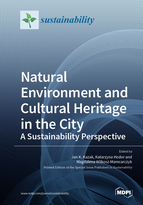Natural Environment and Cultural Heritage in the City, A Sustainability Perspective
A special issue of Sustainability (ISSN 2071-1050). This special issue belongs to the section "Sustainable Urban and Rural Development".
Deadline for manuscript submissions: closed (30 April 2021) | Viewed by 74550
Special Issue Editors
Interests: sustainable cities and regions; adaptation to climate change; environmental impact assessment; natural resource management; resilience; urban design and planning
Special Issues, Collections and Topics in MDPI journals
Interests: spatial analysis; urban planning; city planning; landscape architecture; protection heritage; landscape planning; landscaping; landscape; cultural landscapes; landscape design; landscape urbanism; landscape aesthetics; urbanism; heritage conservation; landscape history
Special Issues, Collections and Topics in MDPI journals
Interests: suburbanization; semiurbanization processes; revitalization processes; garden art; urban design; planning; heritage; landscape; cultural landscapes; rural landscape
Special Issues, Collections and Topics in MDPI journals
Special Issue Information
Dear Colleagues,
The 21st century urges us to analyse urban problems and revise its components. Cities in the past followed various evolutionary paths depending on the level of development of the society, its ideology, or financial factors. The key was self-reliant and polycentric production, services, commerce, and finance. What is essential today in the effort to improve the quality of life and support residents throughout the transformation is activities aimed at implementing changes to create friendly and climate-neutral spaces. It is the city that is the focal point of human life on our planet and where critical ecological challenges lie.
All above mentioned issues require the involvement and lot of activities on the different levels. One of the leading Institution is ICOMOS which is very active on this area. They developed ‘ICOMOS SDGs Policy Guidance’ which is a main initiative in Sustainability.
The proposed topical scope combines two basic yet highly relevant issues that affect the cities today, the natural and urban environment viewed from various angles and through different relations. Both are investigated from distinctive perspectives, dedicated sciences: ecology and history, respectively, including heritage and monument conservation. Research focusing on urban and suburban zones will be rather interesting.
We propose a new research perspective. On the one hand, it takes advantage of ecological experience, and on the other, it explores historical and heritage conservation problems, to finally combine them using landscape research. We ponder the City, its ecology, past and modern culture, and particularly cultural heritage from the angle of research on the image, aesthetics, form, and function of the urbanscape.
In general, the topics of interest include the impact of concepts of urban ecological networks that provide not only a background for the structure but constituting a crucial city-forming factor. It seems vital to search for the right development directions and methods to be used to combine these values, and to propose a statutory and methodological footing for various locations. The cultural value, based on regional inputs through historical structures and components is an indisputable quality important for landscape conservation. Aesthetics, biodiversity, and selection of actions fit for the scale and type of problems are important focuses for research and development in the context of the cultural heritage of historical cities. The effort to combine ecological values with heritage resources to protect landscapes should be systemic to bear the fruit of their preservation for the next generations. We propose to determine guidelines aimed at developing procedural standards in individual groups.
Another essential matter will be the international exchange of views and research, which may improve relevant methods.
Dr. Jan K. Kazak
Dr. Katarzyna Hodor
Dr. Magdalena Wilkosz-Mamcarczyk
Guest Editors
Manuscript Submission Information
Manuscripts should be submitted online at www.mdpi.com by registering and logging in to this website. Once you are registered, click here to go to the submission form. Manuscripts can be submitted until the deadline. All submissions that pass pre-check are peer-reviewed. Accepted papers will be published continuously in the journal (as soon as accepted) and will be listed together on the special issue website. Research articles, review articles as well as short communications are invited. For planned papers, a title and short abstract (about 100 words) can be sent to the Editorial Office for announcement on this website.
Submitted manuscripts should not have been published previously, nor be under consideration for publication elsewhere (except conference proceedings papers). All manuscripts are thoroughly refereed through a single-blind peer-review process. A guide for authors and other relevant information for submission of manuscripts is available on the Instructions for Authors page. Sustainability is an international peer-reviewed open access semimonthly journal published by MDPI.
Please visit the Instructions for Authors page before submitting a manuscript. The Article Processing Charge (APC) for publication in this open access journal is 2400 CHF (Swiss Francs). Submitted papers should be well formatted and use good English. Authors may use MDPI's English editing service prior to publication or during author revisions.
Keywords
- urban ecology
- urban metabolism
- structures of cultural heritage
- heritage relationships
- historical greenery (gardens and parks)
- urban ecological network solutions
- urban ecosystems
- urban–suburban relation
- blue-green infrastructure
- conservation activities in urban and suburban zones
- urbanscape
- suburban solutions
- impact of historical conditions on the modern city
- urban and suburban regionalism
- urban and suburban biodiversity








